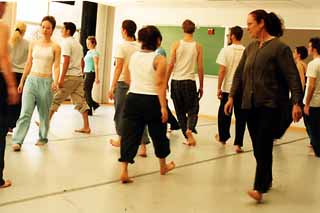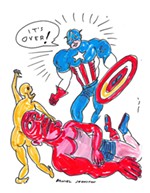The Basics, With Bogart
By Robert Faires, Fri., Feb. 15, 2002

Nine people walk across the studio floor. Their paths are individual, random; they move at varying paces, in various directions. But gradually, the different patterns they're creating resolve into one, and they begin moving as a single entity, like birds in a flock or fish in a school, remaining unified in a line or formation even when a shift in direction or speed takes place, each walker preserving the space between himself and the others in the group. Then, when one of the nine begins a different movement, the rest gradually follow her lead until all nine are one again.
It's as remarkable a sight as it is in nature, and all the more remarkable because it isn't choreographed, because there's no spoken direction guiding these walkers as they move across the floor. Instead, each of the nine has extended his or her field of perception to include the other eight, so that everyone is at all times aware of what everyone else is doing and can adjust very quickly his or her movements when a shift in the group happens. By remaining open to each other, these nine individuals have forged an uncommon bond.
The usefulness of this isn't lost on any of the nine walkers or any of the 21 people sitting against one wall of the studio watching them. They are all theatre people -- actors, directors, choreographers, teachers -- and the kind of unity that's been created here can be incredibly powerful on stage, in terms of compelling imagery, theatrical tension, forging an ensemble, and more. They nod, they grin, lights spark on in their eyes: This is great stuff! And so simple: People. Walking. In a Space.
And so it goes with Anne Bogart on this sunny Saturday in a rehearsal studio at St. Edward's University. The internationally celebrated director and co-founder of the Saratoga International Theatre Institute -- better known now as the SITI Company -- communicates one sage lesson after another about the nature of performance, stage movement, theatricality, through the simplest of exercises. Walk in a group of people. Make the group form a line or circle or clump without speaking. Express an experience through a chain of movements. Incorporate text into the chain of movements. Find a partner and merge your two chains of movement into one. It's so basic.
But that's what turns out to be so inspiring about Bogart during her visit to Austin. She brings you back to the fundamentals of the art, and in a way that makes them seem very fresh. "Theatre is not about understanding," she told an audience of students and guests on Friday afternoon. "It's about an experience." Approaching the art form rationally, with the idea that it's supposed to explain everything, diminishes its impact; it lets us see a play and move on, leaving the experience behind. Art has the power to stop us in our tracks, to shake us up, to stay with us. But to take advantage of that, we have to understand that interest is "the major tool of the artist." That's what keeps the audience awake and leaning forward in their seats. The title of her talk said it all: "Why Are We Here and What Are We Doing." You have to confront those basic questions if you expect to create art that connects with an audience.
Throughout Bogart's speech, in which she walked the audience through her own evolution as a director, and throughout the weekend, the director distilled issues facing artists to the basics, and did so with warmth, humor, and clarity (which was amazing considering that she was beset with the flu all weekend). She left the city Sunday with many new fans and friends.
Bogart's departure won't be the end of the SITI Company presence in Austin this spring. The workshop was the prelude to an ambitious project the St. Edward's Theatre Department is undertaking. Under the direction of SITI Company member J. Ed Arazia (who was also present this past weekend) and a couple of his colleagues, a group of St. Ed's students will use SITI techniques to create a new theatre piece called The Medea Stories, exploring the nature of mythology and who gets to tell whose stories.
The Medea Stories runs April 12-23 at the Mary Moody Northen Theatre at St. Edward's University. Call 448-8484 for information.








